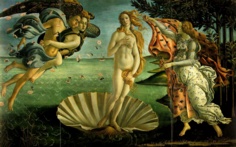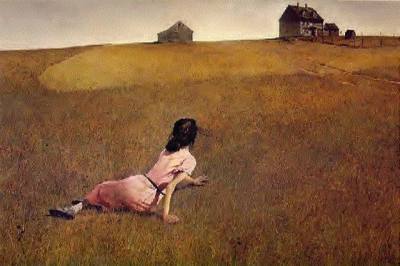tempera and temper
- A paint and process
involving an emulsion
of oil and water. It was in use before the invention of oil
paints. Traditionally it involves an egg emulsion; thus the
term egg tempera. The pigments or colors
are mixed with an emulsion of egg yolks (removed from their sacs)
or of size, rather than
oil, and can be thinned
and solved with water.
Also known as egg tempera and temper.
A varnish for tempera paints,
called glair may be prepared
by mixing egg whites with a little water, then beating them, and
applying once the bubbles are gone.
Because some of its ingredients
are organic, tempera may spoil, and get very smelly. Claims have
been made that when any one of the following substances are added,
it reverses the growth of bacteria in tempera: benzoate of soda,
bath salts, table salt, soap or cleanser such as 409, alcohol
or bleach (one capful per gallon of tempera).
Examples of painting with tempera:

Simone Martini (Italian, c. 1284-1344), Madonna from the Annunciation, 1340-1344,
tempera on wood
panel, 12 x 8 1/2 inches (30.5
x 21.5 cm), State Hermitage Museum, St. Petersburg, Russia. See
Gothic and
Middle Ages.

Giovanni Bellini (Italian, 1430?-1516), Christ's
Blessing, 1460, tempera on wood
panel, Louvre. Also see Renaissance.
Giovanni Bellini (Italian, 1430?-1516), The Lamentation over the Body of Christ, 1500, tempera on wood panel, Uffizi. See Renaissance.

Sandro Botticelli (Italian, 1445-1510), The
Adoration of the Magi, 1470-75, tempera on wood
panel, 111 x 134 cm, Uffizi, Florence.
See Renaissance.
Sandro Botticelli, Madonna of the Magnificat, c.1485, tempera on wood panel, diameter 118 cm, Uffizi, Florence. See tondo.

Sandro Botticelli (Italian, 1444-1510), Birth of Venus, c. 1485-86, painted for the villa of
Lorenzo di Pierfrancesco de' Medici at Castello, tempera on wood panel,
67 7/8 x 109 5/8 inches (172.5 x 278.5 cm), now in the Uffizi,
Florence.
Sandro Botticelli, The Cestello Annunciation, c. 1489, tempera on wood panel, 150 x 156 cm, Uffizi, Florence.
Sebastiano Mainardi (Italian, 1450-1513), Madonna and Child with Saint John and Three Angels, c. 1500, tempera on wood panel, 33 3/4 x 33 3/4 inches, Birmingham Museum of Art.

Leonardo da Vinci (Italian, 1452-1519), Madonna and Child (Madonna Litta), c.
1490-91, tempera on canvas,
transferred from panel, 16 1/2 x 13 inches (42 x 33 cm), Hermitage
Museum, St. Petersburg, Russia. See Renaissance.
Michelangelo Buonarotti (Italian, 1475-1564), The Holy Family with the infant St. John the Baptist (the Doni Tondo), c. 1503-05, tempera on wood panel, diameter 47 inches (120 cm), Uffizi, Florence. Also see High Renaissance and tondo.

Raffaello Sanzio "Raphael" (Italian,
1483-1520), Madonna and Child (Madonna Conestabile),
1502/3, tempera on canvas
(transferred from panel), 7 x 7
inches (17.5 x 18 cm), State Hermitage Museum, St. Petersburg,
Russia. See tondo.

Pablo Picasso (Spanish, 1881-1973), Sleeping Peasants, 1919, tempera, watercolor
and pencil on paper,
12 1/4 x 19 1/4 inches (31.1 x 48.9 cm), Museum of Modern Art,
NY.

Ben Shahn (American, born Lithuania, 1898-1969),
Scorn, 1952, tempera paint on paper,
39 x 25 1/4 inches, Kemper Museum of Contemporary Art, Kansas
City, MO. See Jewish art.
Jacob Lawrence (American, 1917-2000), The Library, 1960, tempera on fiberboard, 24 x 29 7/8 inches (61.0 x 75.9 cm), National Museum of American Art, Washington, DC. See Harlem Renaissance.
Andrew Wyeth (American, 1917-), Dodges Ridge, 1947, egg tempera on fiberboard, 41 x 48 inches (104.2 x 122.0 cm), National Museum of American Art, Washington, DC.

Andrew Wyeth, Christina's World, 1948, tempera on gessoed panel,
32 1/4 x 47 3/4 inches, Museum of Modern Art, NY. See what this
house — the Olson House, Cushing, Maine — looks like
today.
Also see stain removal.
https://inform.quest/_art